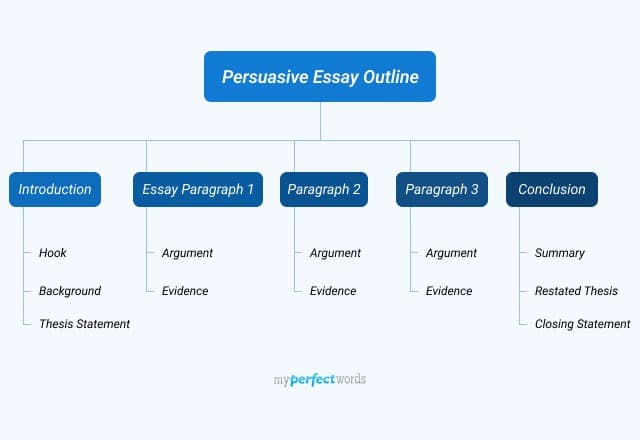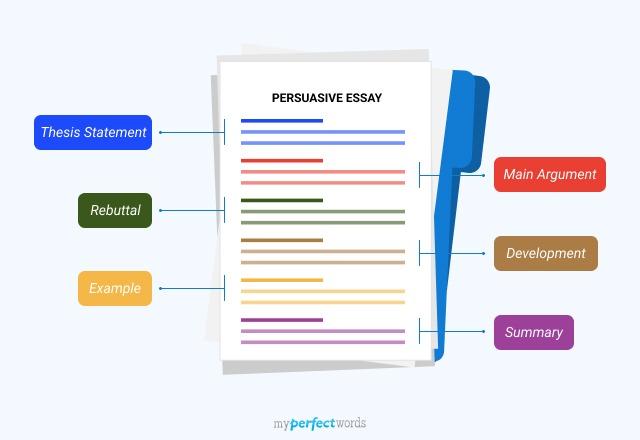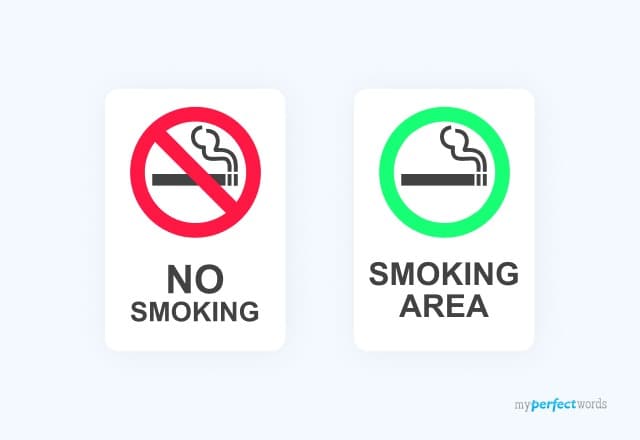Imagine being able to sway opinions, influence decisions, and convince others with the power of words.
That’s what good persuasive writing can help you achieve! Persuasive essays provide you an opportunity to express your opinions, convince your readers, inspire action, and make a lasting impact.
So how can you write a great persuasive essay?
If you're eager to learn the art of persuasive writing, you're in the right place. In this guide, we’ll dive into the step-by-step writing process that can help you. You’ll also get example essays and tips that will make your persuasive writing stand out.
Let’s dive in!
On This Page![]()
- 1. What is a Persuasive Essay?
- 2. The 3 Elements of Persuasion
- 3. How to Write a Persuasive Essay
- 4. Persuasive Essay Structure
- 5. Persuasive Essay Examples
- 6. Persuasive Essay Topics for Students
- 7. Tips for Writing Stand-Out Persuasive Essays
What is a Persuasive Essay?
A persuasive essay is a form of essay writing that aims to convince its audience to adopt a particular viewpoint or take a specific course of action.
The writer takes a clear position on an issue and attempts to convince the readers through different persuasive techniques, such as evidence and anecdotes. The point is to resonate with the readers emotionally AND logically on a specific issue.
It's like being a lawyer in a courtroom, making a compelling argument to sway the jury (your readers) to your side. The goal of a persuasive essay can vary, from changing the readers’ opinion on a controversial topic to inspiring them to support a cause or take action on an issue.
What’s the Difference Between Persuasive & Argumentative Essays?
Persuasive and argumentative essays are often confused with each other, but they have distinct differences in terms of their purpose and approach.
Here are the main differences between persuasive vs. argumentative essays:
Persuasive Essay | Argumentative Essay |
These essays often use emotional appeals and a friendly, passionate tone to connect with the reader. The writer may share personal experiences or stories to make their point. | They typically maintain a more formal and objective tone. They rely solely on facts, evidence, and logical reasoning rather than emotional appeals. |
Its primary purpose is to persuade or convince the reader to adopt the writer's viewpoint or take a specific action. It focuses on changing the reader's beliefs or behavior. | Its main purpose is to present a well-reasoned, logical argument with the goal of convincing the reader that a particular viewpoint or claim is valid and supported by evidence. |
The 3 Elements of Persuasion
Before we get into the writing steps, we must understand the basic elements of persuasion. These elements, known as "ethos," "pathos," and "logos," are fundamental to crafting a persuasive essay that resonates with your audience and effectively conveys your message.
- Ethos: Building Credibility and Trust
Ethos, derived from the Greek word for "character," focuses on establishing your credibility as a writer and gaining the trust of your readers. It involves establishing one's authority, expertise, and reliability in the eyes of the audience. In a persuasive essay, ethos is often established through:
- Demonstrating expertise on the subject matter.
- Citing credible sources and references.
- Maintaining a respectful and professional tone.
- Acknowledging and addressing opposing viewpoints.
These steps can help you gain the trust of your readers. Ethos provides them a reason to trust you and listen to your arguments.
- Pathos: Stirring Emotions and Empathy
Pathos is the appeal to emotion that is aimed at evoking specific emotions or empathy from the audience. It seeks to connect with readers on a personal and emotional level. In a persuasive essay, pathos can be incorporated by:
- Using vivid and emotionally charged language.
- Sharing compelling anecdotes or stories.
- Appealing to the values and beliefs of the audience.
- Highlighting the human or emotional impact of the topic.
The emotional aspect is essential to good persuasive writing. Still, it should be used in moderation to be effective.
- Logos: Employing Logic and Reasoning
Logos appeals to the reader's sense of logic and reason. It involves presenting a well-structured, logical argument supported by evidence. In a persuasive essay, logos is evident through:
- Presenting clear and well-structured arguments.
- Providing factual evidence, statistics, and research findings.
- Using logical reasoning and deductive or inductive arguments.
- Addressing and refuting counterarguments effectively.
When used together, these three elements can be effective tools for persuasion. By utilizing all three elements, the speaker increases the chances of influencing their audience. You can read more about ethos, pathos, and logos to understand them better and ensure their correct usage in your writing.
Here is a video you can watch about the three persuasive techniques:
How to Write a Persuasive Essay
Persuasive essays are very common, especially for students. However, they are challenging to write if you don’t know where to start. Here are the steps that can help make your writing process easier.
Step 1: Select an Interesting Topic & Define Your Position
Choosing a topic is the most crucial part. Your topic should be engaging and debatable, in which you can clearly define your position. Here are some tips for selecting a topic:
- Identify Your Interests: You should consider something that is interesting to you too, as this will make it easier and enjoyable for you to write about it.
- Consider Your Audience: Think about who your target audience is. Your topic should resonate with them and be relevant to their interests, concerns, or beliefs.
- Define Your Position: Clearly define your stance or position on your potential topics. Ask yourself: What do I want to persuade my audience to believe or do regarding this topic? What are the key points or arguments I will use to support my position?
- Avoid Overly Broad or Narrow Topics: Ensure that your topic is neither too broad nor too narrow. An overly broad topic may lack focus, while an overly narrow one may not provide enough material for a persuasive argument.
Step 2: Research & Gather Evidence
Gather credible sources, statistics, facts, and evidence to support your argument. Conducting thorough research uncovers the themes, arguments, and discussions about your topic, helping you find the best arguments you need.
While collecting information, take detailed notes so you can cite sources later. You also have to evaluate the evidence and prioritize those points that can better support your position.
Step 3: Make an Outline
Now that you’ve gathered your main points, you need to organize them in a logical structure. Outline the structure of your essay with a clear introduction, body paragraphs, and conclusion. Here are the main points you should include in your first outline:
- Thesis: State the thesis statement of your essay to present your main argument. It should clearly mention your position on the topic and how you are going to argue for it.
- Body Paragraphs: The body paragraph outline should contain the topic sentence and supporting points. Mention clear and concise topic sentences that introduce the main point of each paragraph.
- Supporting Evidence: Also add supporting evidence, examples, statistics, or quotes for each paragraph that bolster your argument. Ensure each piece of evidence is relevant and directly supports your point.
- Conclusion: If your persuasive essay aims to prompt a specific action or response from the reader, include a call to action in your outline. Clearly state what you want your audience to think or do after reading your essay.
See this outline format below to understand better:
Want to learn more about making an outline? Check out our complete guide to crafting a persuasive essay outline.
Step 4: Write Your First Draft
With a solid outline in place, it's time to start crafting your persuasive essay's first draft. Follow these guidelines to write your initial draft effectively:
- Follow the Outline: Refer to your outline as your roadmap. Begin by writing the introduction, followed by the body paragraphs, addressing each point in the order outlined. Finish with the conclusion.
- Write Freely: In the first draft, focus on getting your ideas down on paper without worrying too much about perfection. Don't be overly concerned about grammar, spelling, or word choice at this stage; you can edit and refine later.
- Maintain a Consistent Tone: Maintain a tone that aligns with your persuasive goals, whether it's authoritative, passionate, or empathetic. Consistency in tone will help your argument come across convincingly.
- Support with Evidence: As you develop your arguments in the body paragraphs, ensure that each point is supported with strong evidence, examples, statistics, or quotes from credible sources.
- Address Counterarguments: Incorporate responses to potential counterarguments where relevant, demonstrating a comprehensive understanding of the issue and reinforcing your position.
- Be Concise and Clear: Write concisely, expressing your ideas clearly and avoiding unnecessary jargon or complexity. The clarity of your arguments is crucial for persuading your audience.
Note: Some people may confuse descriptive essays with persuasive essays, but they serve different purposes. A descriptive essay focuses on vividly describing a subject, while a persuasive essay aims to convince the reader of a particular viewpoint. Despite their differences, both require detailed and clear writing to engage the reader.
Step 5: Proofread & Revise
Once you've completed the first draft, take a break to gain some distance from your work. When you return, begin the revision process. Focus on refining your arguments, improving clarity, and ensuring that your essay flows logically.
- Proofread: Carefully proofread your first draft for grammar, spelling, and punctuation errors. Improve the essay format and clarity wherever possible.
- Seek Feedback: Share your first draft with peers, teachers, or writing tutors to obtain feedback on the persuasiveness, clarity, and overall effectiveness of your essay. Use this feedback to make necessary improvements.
- Polish Your Draft: After incorporating feedback and revising accordingly, refine your essay to its final form. Ensure that it aligns with your outline and effectively conveys your persuasive message.
- Cite Sources: Remember to include proper citations for all sources used within your essay. Follow the citation style specified by your instructor or guidelines.
Persuasive Essay Structure
A well-structured persuasive essay is essential to effectively convey your argument and persuade your audience. The structure typically consists of three main parts: the introduction, body paragraphs, and conclusion.
A persuasive essay mostly follows a five-paragraph essay structure. With one introduction, three body paragraphs, and a conclusion. However, the number of body paragraphs can extend based on your topic.
Introduction
The essay introduction serves as the gateway to your persuasive essay. Its primary purpose is to grab the reader's attention, provide context for your argument, and present your thesis statement—the core of your persuasive message. Here's how to craft an engaging introduction:
- Hook: Use a catchy essay hook such as an intriguing question, surprising statistic, or relevant anecdote to grab attention.
- Background Information: Provide a brief and relevant overview of the topic to give context and ensure reader understanding.
- Thesis Statement: End with a clear, concise thesis statement that states your position and previews the main points of your essay.
Body Paragraphs
The body paragraphs form the core of your persuasive essay, where you present your point of view and build your case. Here's how to structure and write effective body paragraphs:
- Topic Sentence: Start each body paragraph with a topic sentence that introduces the main point or argument of that paragraph.
- Supporting Evidence: Follow the topic sentence with relevant evidence, examples, statistics, quotes, or facts that support your argument.
- Analysis: After presenting your evidence, analyze it thoroughly. Explain how the evidence supports your thesis and persuades the reader.
- Transition: Use transition words and sentences at the end of each body paragraph to link it to the next one.
Conclusion
The conclusion is where you bring your persuasive essay to a close, summarizing your main points, restating your thesis, and leaving a lasting impression. Follow these guidelines for an effective conclusion:
- Summarize Main Points: Briefly restate the key arguments from the body of your essay.
- Restate Thesis: Rephrase your thesis to emphasize your main message.
- Closing Statement: End with a memorable statement that encourages reflection.
- Avoid New Information: Provide closure without introducing new ideas.
Persuasive Essay Format
After writing the complete essay according to the structure above, you need to ensure correct formatting. Formatting ensures that your essay is readable and presentable.
There are several standardized formatting styles used in writing, such as APA and MLA. If you are writing a persuasive essay as an assignment, always ask your instructor about their preferred format.
Meanwhile, you should format your essay according to these common guidelines:
- Font Style: Times New Roman.
- Font Size: 12pt
- Line Spacing: Double-spaced.
- Alignment: Left Alignment
- Indent: First-Line indent
Persuasive Essay Examples
Studying persuasive essay examples can be immensely helpful in understanding how to craft a compelling and effective persuasive essay.
Check out these sample essays below:
Want more examples? We’ve got you covered! Head to our persuasive essay examples blog to find persuasive papers on various topics.
Persuasive Essay Topics for Students
Selecting an engaging and relevant topic is the first step in crafting a persuasive essay. If you are wondering what should I write my persuasive essay on, here are a few persuasive essay prompts:
- Advocate for the reduction of single-use plastics to combat plastic pollution.
- Argue for the inclusion of financial literacy education in high school curricula.
- Argue for responsible usage and regulations to combat the negative influence of social media.
- Persuade readers of the benefits of universal healthcare.
- Take a stance on the importance of online privacy and stronger data protection laws.
- Argue for electoral reform, such as ranked-choice voting, to improve the fairness and effectiveness of elections.
- Convince your audience of the benefits of supporting local businesses and shopping locally.
- Make a case for stricter penalties against human trafficking.
- Argue for increased public funding for the arts to support creativity and cultural enrichment.
- Argue for or against the use of artificial intelligence and automation in the workplace.
Need more ideas? Check out our compilation of 200+ persuasive essay topics and find the best topic.
Tips for Writing Stand-Out Persuasive Essays
Now that you know how to write your essay and have read some examples, you are able to write a good persuasive essay. However, you can make it even better with the following tips and techniques:
- Clarity and Conciseness: Write in a clear and concise way. Avoid jargon or overly complex language to make your message easily understandable.
- Use Persuasive Techniques: Employ persuasive language and rhetoric techniques, such as ethos, pathos, and logos, to appeal to your audience's emotions, ethics, and logic. Use powerful verbs, descriptive adjectives, and vivid metaphors to make your writing engaging.
- Tell a Compelling Story: Use storytelling techniques to illustrate your points. Engaging narratives can make your arguments more relatable and memorable.
- Provide Real-Life Examples: Support your arguments with concrete, real-life examples and case studies. Personal anecdotes or case stories can be particularly persuasive.
- Address the Reader Directly: Use the second-person point of view (you) to address the reader directly, making your essay more engaging and relatable.
- Maintain a Confident Tone: Maintain a confident and assertive tone throughout your essay. Confidence in your message can persuade readers to adopt your viewpoint.
- Provide Solutions: Suggest practical solutions or actions that can be taken to address the issue you're discussing. Offering a path forward can be persuasive.
To conclude,
You’ve learned how to craft a persuasive essay that grabs attention and makes a strong case. With the tips and examples provided, you can now make your arguments even more compelling.
Ready to start writing your persuasive papers? Dive in and use these techniques to inspire others.
If you need a bit of extra help, you can always ask, “Can I pay to do my essay?” Our team is here to provide top-notch writing services. Just buy speech from us, and we’ll ensure you get a standout essay.
So, get in touch with our persuasive essay writing service today for guaranteed results!
Frequently Asked Questions
What are the 4 P's of persuasive writing?
The 4 P's of persuasive writing are:
- Promise: Make a compelling promise to the reader about what they will gain or understand.
- Picture: Create a vivid picture of the benefits or consequences to engage the reader’s emotions.
- Proof: Provide solid evidence and logical arguments to support your claims.
- Push: Encourage the reader to take action or adopt your viewpoint.
What not to write in a persuasive essay?
Avoid using vague statements, unsupported claims, overly emotional appeals, and biased language. Refrain from including irrelevant details, over-generalizations, and weak evidence.
What is a good sentence starter for a persuasive essay?
Some good sentence starters for a persuasive essay can be:
- "Imagine a world where..."
- "Have you ever considered..."
- "What if I told you that..."
What are the 5 primary elements of the persuasive essay?
The 5 primary parts of a persuasive essay are:
- Introduction with a Hook and Thesis Statement
- Clear and Logical Arguments
- Evidence and Examples
- Counterarguments and Rebuttals
- Strong Conclusion
What does a persuasive essay need?
A persuasive essay requires a clear thesis statement, logical arguments supported by evidence, counterarguments with rebuttals, and a strong conclusion. It should be well-organized, use persuasive language, and address the reader’s potential objections.

Write Essay Within 60 Seconds!
Use our AI tool to generate high quality essay
WRITTEN BY
Caleb S.
Caleb S. has been providing writing services for over five years and has a Masters degree from Oxford University. He is an expert in his craft and takes great pride in helping students achieve their academic goals. Caleb is a dedicated professional who always puts his clients first.
Keep reading
A Catalogue of 300 Best Persuasive Essay Topics for Students

Persuasive Essay Outline - A Complete Guide

30+ Persuasive Essay Examples To Get You Started

Read Excellent Examples of Persuasive Essay About Gun Control
-9213.jpg&w=828&q=75)
How to Write a Persuasive Essay About Covid19 | Examples & Tips

How To Write A Persuasive Essay On Abortion
-9248.jpg&w=828&q=75)
Learn to Write a Persuasive Essay About Business With 5 Best Examples

Check Out 14 Persuasive Essays About Online Education Examples

Persuasive Essay About Smoking - Making a Powerful Argument with Examples

